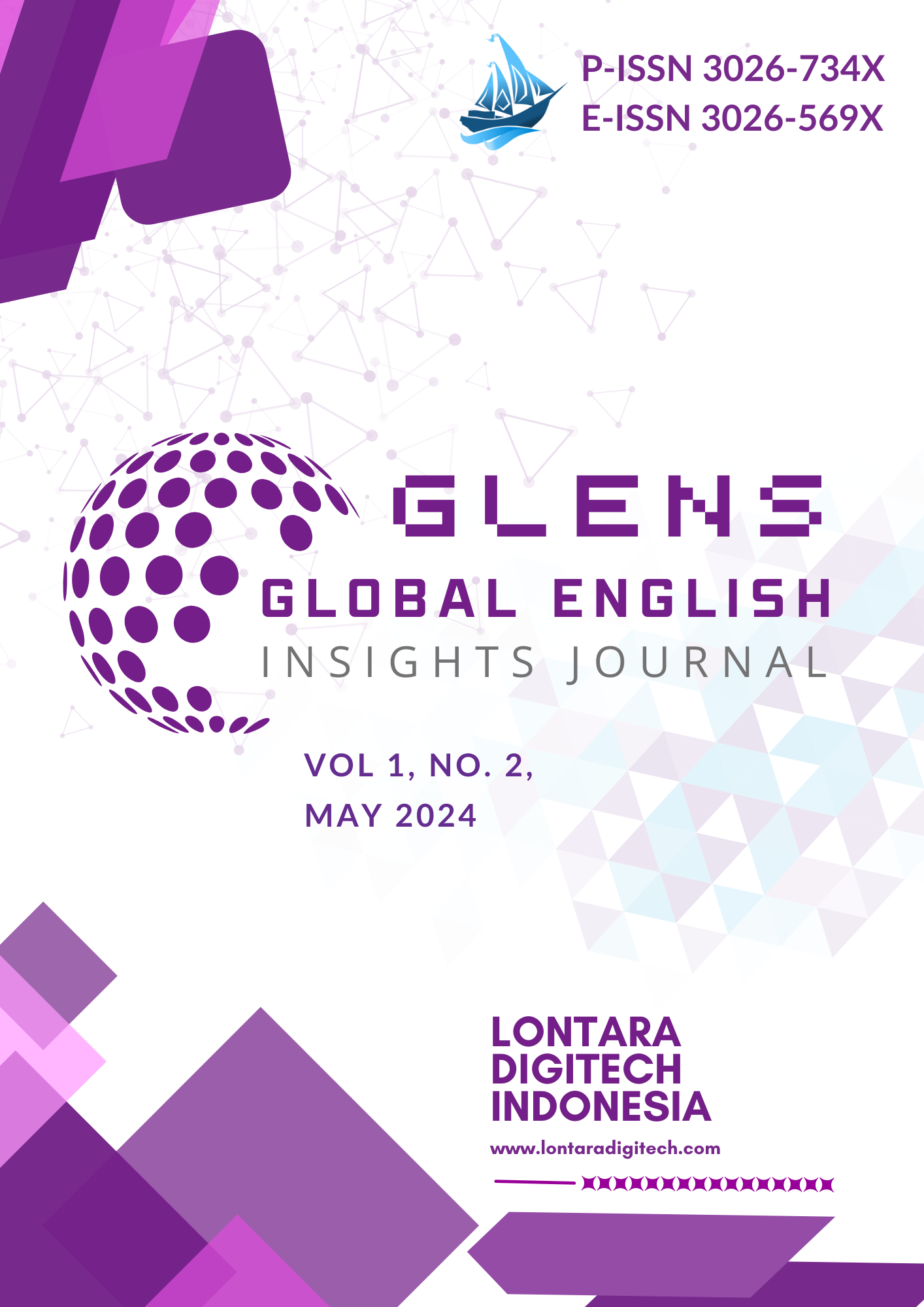YouTube for EFL Students: Perceptions on Building Speaking Confidence
DOI:
https://doi.org/10.61220/glens.v1i2.350Kata Kunci:
EFL Students, Perception, Speaking, YouTubeAbstrak
This study aimed to investigate students' perceptions of utilizing YouTube as a learning medium to foster their speaking confidence in English. Specifically, it explored students' views on YouTube's accessibility, usefulness, and practicality while examining its potential to enhance their confidence in speaking English. The researchers collected data through questionnaires and interviews with 10 second-grade students from SMAN 1 Tinambung. The findings revealed that students perceived YouTube as an accessible and user-friendly platform, aiding their comprehension and vocabulary expansion. Furthermore, they found it useful and motivating to practice proper English-speaking skills. Notably, students acknowledged YouTube's role in triggering their confidence to speak English, whether in front of a camera or in class settings. Peer feedback and comments were deemed valuable for augmenting knowledge and confidence. The questionnaire data indicated positive perceptions, with 80% acknowledging YouTube's accessibility, 82% recognizing its usefulness, 84% appreciating its practicality, and 72% reporting increased confidence levels. The interview data further corroborated these findings, with most students endorsing the continued integration of YouTube, as it facilitated their understanding of lesson materials and bolstered their confidence in spoken English. The study underscored YouTube's potential as an effective learning medium for developing EFL learners' speaking confidence.
Referensi
Alias, M., Mohd Rasdi, R., Ismail, M., & Abu Samah, B. (2013). Influences of individual-related factors and job satisfaction on workplace deviant behaviour among support personnel in Malaysian public service organizations. Human Resource Development International, 16(5), 538–557. https://doi.org/10.1080/13678868.2013.812315
Brown, H. D., & Lee, H. (2015). Teaching by principles: An interactive approach to language pedagogy. Pearson.
Haryudin, A., & Jamilah, S. A. (2018). Teacher’s Difficulties in Teaching Speaking Using Audio Visual Aid for Autistic Students. Journal of English Language Teaching in Indonesia, 6(2), 107. https://doi.org/10.22460/eltin.v6i2.p107-116
Isma, A. (2023a). Enhancing digital literacies with adult English language learners: Theoretical and practical insights. TESOL Journal. https://doi.org/10.1002/tesj.752
Isma, A. (2023b). Emerging Trends of ICT in Teaching and Learning: ICT in English Language Teaching. LLT Journal: A Journal on Language and Language Teaching, 26(2), 812–815. https://doi.org/10.24071/llt.v26i2.6172
Isma, A., Basri, M., Abduh, A., Putri, A. M. J., & Hustiana, H. (2024). Empowering E-Learning for English Literacy Development: Insights from Lecturers. JETAL: Journal of English Teaching and Applied Linguistics, 5(2), 146–153. https://doi.org/10.36655/jetal.v5i2.1495
Isma, A., Hermansyah, S., Ramadhani, Y. R., Lestari, I. W., Evenddy, S. S., Talenta, P. I., Sastri, L., Rasmin, L. O., Febrianto, A. R., & Pavita, M. D. A. (2023). Teaching English to 21st Century Learners (1st ed.). Yayasan Kita Menulis.
Isma, A., Lestari, I. W., Halim, A., Halim, N. M., Sastri, L., Ramadhani, Y. R., Sari, I. M., Simarmata, J., Ritnawati, & Nurlely, L. (2024). Innovative Approaches to Teaching English: Exploring the Power of Technology (1st ed.). Yayasan Kita Menulis.
Isma, A., Lestari, I. W., Rohimajaya, N. A., Hardiyanto, A., Susanti, E., Meisarah, F., Novia, S., Kuning, D. S., Hamer, W., & Rasmin, L. O. (2024). Digital Tools for English Language Learning: A Comprehensive Guide for EFL Educators (1st ed.). Yayasan Kita Menulis.
Isma, A., Sudewi, P. W., & Amrang, A. (2024). Exploring the Attitudes of English Language Learners toward Online Learning in Indonesian Higher Education. The Journal of Asia TEFL, 21(1), 207–216. https://doi.org/10.18823/asiatefl.2024.21.1.13.207
Kurniawan, I.-, Sabaruddin, S., & J, F. G. (2018). An Analysis of Students’ English Speaking Skill at Coastal Schools of Bengkulu City, Indonesia. Journal of English Language Studies, 3(1), 18. https://doi.org/10.30870/jels.v3i1.2212
Kurniawan, I. (2018). Student’s Perception on the Use of Youtube as a Learning Media to Improve Their Speaking Skill. International Seminar and Annual Meeting BKS-PTN Wilayah Barat, 1(1), 324–329. http://conference.unsri.ac.id/index.php/semirata/article/download/1130/504
Megawati, F., & Mandarani, V. (2016). Speaking problems in English communication. The 1st English Language Teaching Learning Conference (ELTIC): Its Trends of Curriculum Challenges to Face ASEAN Economic Community, 32–37.
Orús, C., Barlés, M. J., Belanche, D., Casaló, L., Fraj, E., & Gurrea, R. (2016). The effects of learner-generated videos for YouTube on learning outcomes and satisfaction. Computers & Education, 95, 254–269. https://doi.org/10.1016/j.compedu.2016.01.007
Phillips, N., & Lindsay, G. (2006). Motivation in gifted students. High Ability Studies, 17(1), 57–73. https://doi.org/10.1080/13598130600947119
Shadiev, R., Hwang, W.-Y., & Liu, T.-Y. (2018). Investigating the effectiveness of a learning activity supported by a mobile multimedia learning system to enhance autonomous EFL learning in authentic contexts. Educational Technology Research and Development, 66(4), 893–912. https://doi.org/10.1007/s11423-018-9590-1
Subramaniam, G. K. J., Abdullah, F. P., & Harun, R. N. S. R. (2013). Polytechnic students’ perceptions of youtube usage in the English oral communication classroom. International Journal of Asian Social Science, 3(9), 1962–1966.
Sudewi, P. W. (2020). Learning Experiences Using Blended Learning on EFL Learners at Sulawesi Barat University. Jurnal Basis, 7(1), 121–132. https://doi.org/10.33884/basisupb.v7i1.1787
Sudewi, P. W. (2021). Students perception of e-learning: A case study on the English students at Sulawesi Barat University. E-Journal of Linguistics, 15(1), 75–82.
Sudewi, P. W., & Isma, A. (2023). Students’ Perception on Utilization of Technology in Listening Learning. Scope: Journal of English Language Teaching, 8(1), 160–166. https://doi.org/10.30998/scope.v8i1.18331
Unduhan
Diterbitkan
Citation
Terbitan
Bagian
Lisensi
Hak Cipta (c) 2024 Musdayanti, Putu Wahyu Sudewi, Nurhaeni (Author)

Artikel ini berlisensiCreative Commons Attribution-ShareAlike 4.0 International License.



















 Email: journalglens@gmail.com
Email: journalglens@gmail.com
